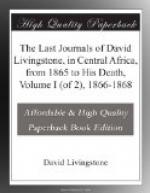The two Arab traders now in the country felt that they must unite their forces, and thereby effect a safe retreat. Chikumbi had kept twenty-eight tusks for Syde bin Omar safely; but the coming of Casembe might have put it out of his power to deliver up his trust in safety, for an army here is often quite lawless: each man takes to himself what he can. When united we marched from Kizinga on 23rd September together, built fences every night to protect ourselves and about 400 Banyamwezi, who took the opportunity to get safely away. Kombokombo came away from his stockade, and also part of the way, but cut away by night across country to join the parties of his countrymen who still love to trade in Katanga copper. We were not molested, but came nearly north to the Kalongosi. Syde parted from us, and went away east to Mozamba, and thence to the coast.
FOOTNOTES:
[64] The allusion is to Mrs. Livingstone’s grave.
[65] At one season the long grass which covers the face of the country catches fire. For some three months the air is consequently filled with smoke.—ED.
CHAPTER XIII.
Cataracts of the Kalongosi. Passage of the river disputed. Leeches and method of detaching them. Syde bin Habib’s slaves escape. Enormous collection of tusks. III. Theory of the Nile sources. Tribute to Miss Tinne. Notes on climate. Separation of Lake Nyassa from the Nile system. Observations on Victoria Nyanza. Slaves dying. Repentant deserters. Mohamad Bogharib. Enraged Imbozhwa. An attack. Narrow escape. Renewed attack. A parley. Help arrives. Bin Juma. March from the Imbozhwa country. Slaves escape. Burial of Syde bin Habib’s brother. Singular custom. An elephant killed. Native game-laws. Rumour of Baker’s Expedition. Christmas dinners.
11th October, 1868.—From Kizinga north the country is all covered with forest, and thrown up into ridges of hardened sandstone, capped occasionally with fine-grained clay schist. Trees often appear of large size and of a species closely resembling the gum-copal tree; on the heights masukos and rhododendrons are found, and when exposed they are bent away from the south-east. Animals, as buffaloes and elephants, are plentiful, but wild. Rivulets numerous, and running now as briskly as brooks do after much rain in England. All on the south-western side of Kalongosi are subjects of Casembe, that is Balunda, or Imbozhwa.
It was gratifying to see the Banyamwezi carrying their sick in cots slung between two men: in the course of time they tired of this, and one man, who was carried several days, remained with Chuma. We crossed the Luongo far above where we first became acquainted with it, and near its source in Urungu or Usungu Hills, then the Lobubu, a goodly stream thirty yards broad and rapid with fine falls above our ford, which goes into Kalongosi.




